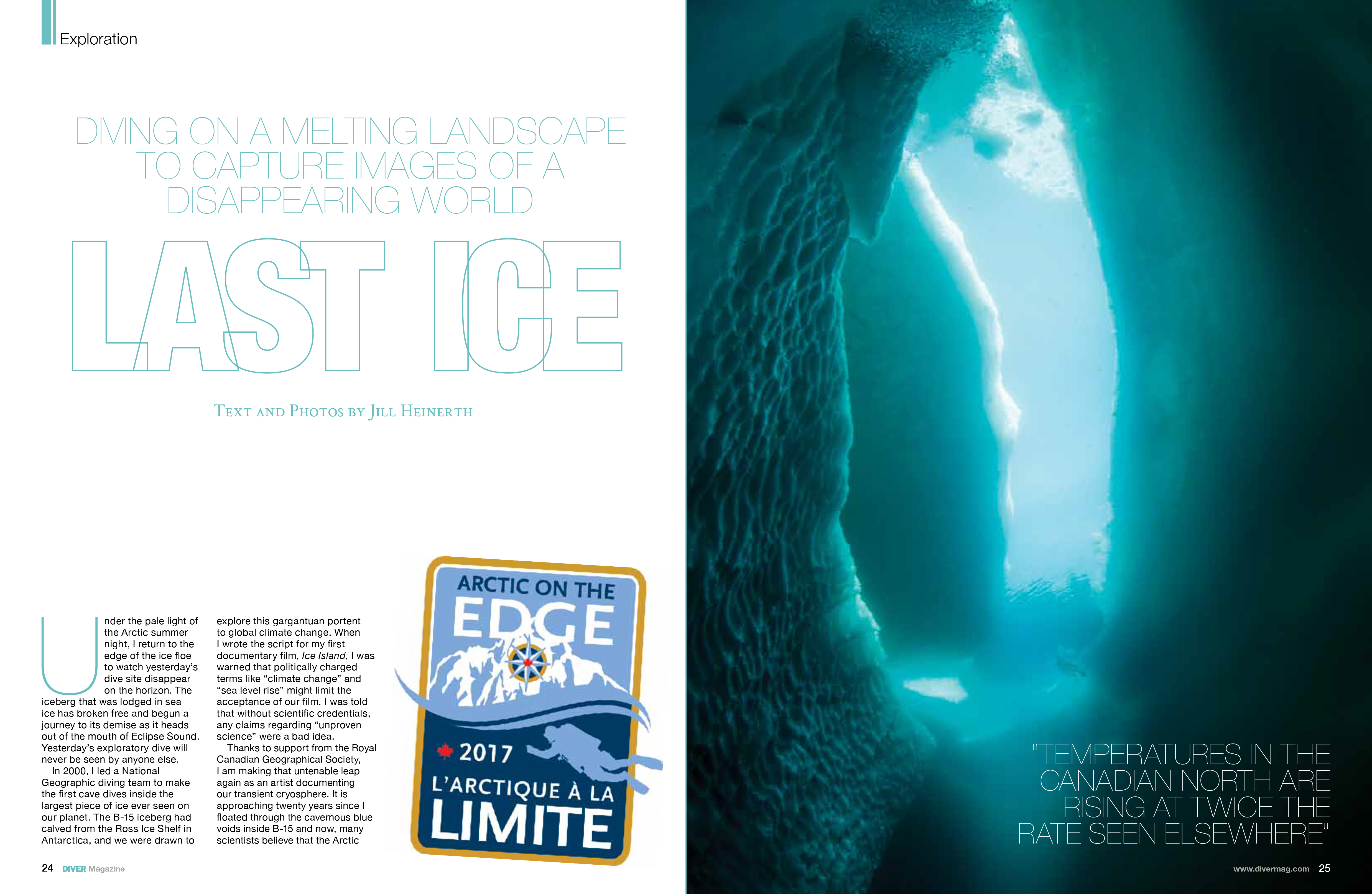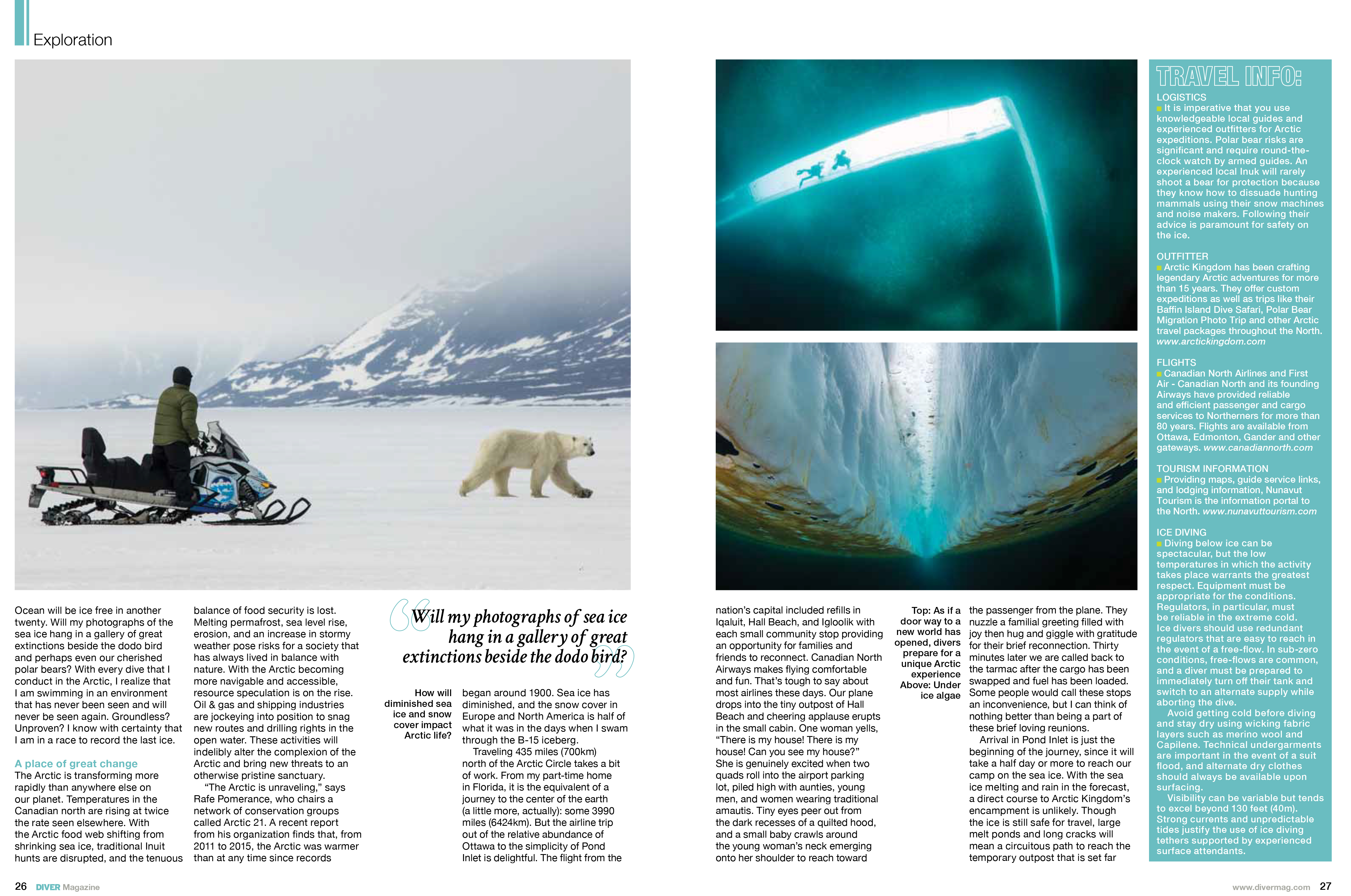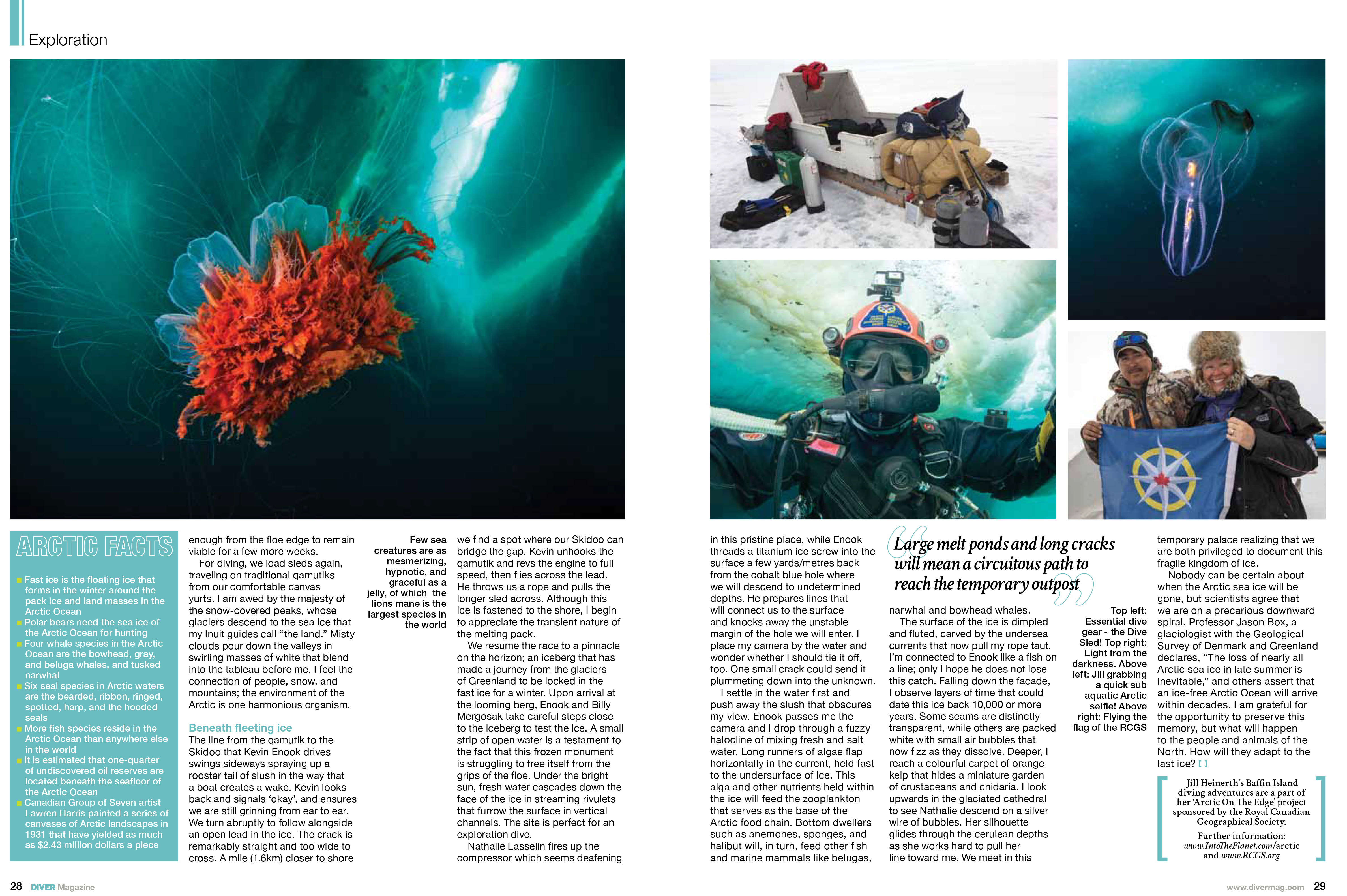Reprinted from DIVER Magazine: Volume 42, October 2017 – Diving the Transitional Environments of Bylot Island by Jill Heinerth
Under the pale light of the Arctic summer night, I return to the edge of the ice floe to watch yesterday’s dive site disappear on the horizon. The iceberg that was lodged in sea ice has broken free and begun a journey to its demise as it heads out of the mouth of Eclipse Sound. Yesterday’s exploratory dive will never be seen by anyone else.
In 2000, I led a National Geographic diving team to make the first cave dives inside the largest piece of ice ever seen on our planet. The B-15 iceberg had calved from the Ross Ice Shelf in Antarctica, and we were drawn to explore this gargantuan portent to global climate change. When I wrote the script for my first documentary film, Ice Island, I was warned that politically charged terms like “climate change” and “sea level rise” might limit the acceptance of our film. I was told that without scientific credentials, any claims regarding “unproven science” were a bad idea.
Thanks to support from the Royal Canadian Geographical Society, I am making that untenable leap again as an artist documenting our transient cryosphere. It is approaching twenty years since I floated through the cavernous blue voids inside B-15 and now, many scientists believe that the Arctic Ocean will be ice-free in another twenty. Will my photographs of the sea ice hang in a gallery of great extinctions beside the dodo bird and perhaps even our cherished polar bears? With every dive that I conduct in the Arctic, I realize that I am swimming in an environment that has never been seen and will never be seen again. Groundless? Unproven? I know with certainty that I am in a race to record the last ice.
A Place of Great Change
The Arctic is transforming more rapidly than anywhere else on our planet. Temperatures in the Canadian north are rising at twice the rate seen elsewhere. With the Arctic food web shifting from shrinking sea ice, traditional Inuit hunts are disrupted, and the tenuous balance of food security is lost. Permafrost melting, sea level rise, erosion and an increase in stormy weather pose risks for a society that has always lived in balance with nature. With the Arctic becoming more navigable and accessible, resource speculation is on the rise. Oil and gas and shipping industries are jockeying into position to snag new routes and drilling rights in the open water. These activities will indelibly alter the complexion of the Arctic and bring new threats to an otherwise pristine sanctuary.
“The Arctic is unraveling,” says Rafe Pomerance, who chairs a network of conservation groups called Arctic 21. A recent report from his organization finds that, from 2011 to 2015, the Arctic was warmer than at any time since records began around 1900. Sea ice has diminished, and the snow cover in Europe and North America is half of what it was in the days when I swam through the B-15 iceberg.
Traveling 700 km north of the Arctic Circle takes a bit of work. From my part-time home in Florida, it is the equivalent of a journey to the center of the earth; some 6424 km. But the airline trip out of the relative abundance of Ottawa to the simplicity of Pond Inlet is delightful. The flight from my nation’s capital included refills in Iqaluit, Hall Beach, and Igloolik with each small community stop providing an opportunity for families and friends to reconnect. Canadian North Airways makes flying comfortable, delicious and fun. That’s tough to say about most airlines these days. Our plane drops into the tiny outpost of Hall Beach and cheering applause erupts in the small cabin. One woman yells, “There is my house! There is my house! Can you see my house?” She is genuinely excited when two quads roll into the airport parking lot, piled high with aunties, young men, and women wearing traditional amautis. Tiny eyes peer out from the dark recesses of a quilted hood, and a small baby crawls around the young woman’s neck emerging onto her shoulder to reach toward the passenger from the plane. They nuzzle a familial greeting filled with joy then hug and giggle with gratitude for their brief reconnection. Thirty minutes later we are called back to the tarmac after the cargo has been swapped and fuel has been loaded. Some people would call these stops an inconvenience, but I can think of nothing better than being a part of these brief loving reunions.
Arrival in Pond Inlet is just the beginning of the journey since it will take a half day or more to reach our camp on the sea ice. With the sea ice melting and rain in the forecast, a direct course to Arctic Kingdom’s encampment is unlikely. Though the ice is still safe for travel, large melt ponds and long cracks will mean a circuitous path to reach the temporary outpost that is set far enough from the floe edge to remain viable for a few more weeks.
Beneath Fleeting Ice
For diving, we load sleds again, traveling on traditional qamutiks from our comfortable canvas yurts. I am awed by the majesty of the snow-covered peaks, whose glaciers descend to the sea ice that my Inuit guides call “the land.” Misty clouds pour down the valleys in swirling masses of white that blend into the tableau before me. I feel the connection of people, snow, and mountains; the environment of the Arctic is one harmonious organism.
The line from the qamutik to the Skidoo that Kevin Enook drives swings sideways spraying up a rooster tail of slush in the way that a boat creates a wake. Kevin looks back and signals “okay,” and ensures we are still grinning from ear to ear. We turn abruptly to follow alongside an open lead in the ice. The crack is remarkably straight and too wide to cross. A mile closer to shore we find a spot where our Skidoo can bridge the gap. Kevin unhooks the qamutik and revs the engine to full speed, then flies across the lead. He throws us a rope and pulls the longer sled across. Although this ice is fastened to the shore, I begin to appreciate the transient nature of the melting pack.
We resume the race to a pinnacle on the horizon; an iceberg that has made a journey from the glaciers of Greenland to be locked in the fast ice for a winter. Upon arrival at the looming berg, Enook and Billy Mergosak take careful steps close to the iceberg to test the ice. A small strip of open water is a testament to the fact that this frozen monument is struggling to free itself from the grips of the floe. Under the bright sun, freshwater cascades down the face of the ice in streaming rivulets that furrow the surface in vertical channels. The site is perfect for an exploration dive.
Nathalie Lasselin fires up the compressor which seems deafening in this pristine place while Enook threads a titanium ice screw into the surface a few meters back from the cobalt blue hole where we will descend to undetermined depths. He prepares lines that will connect us to the surface and knocks away the unstable margin of the hole we will enter. I place my camera by the water and wonder whether I should tie it off too. One small crack could send it plummeting down into the unknown.
I settle in the water first and push away the slush that obscures my view. Enook passes me the camera and I drop through a fuzzy halocline of mixing fresh and salt water. Long runners of algae flap horizontally in the current, held fast to the undersurface of ice. This alga and other nutrients held within the ice will feed the zooplankton that serves as the base of the Arctic food chain. Bottom dwellers such as anemones, sponges, and halibut will, in turn, feed other fish and marine mammals like belugas, narwhal, and bowhead whales.
The surface of the ice is dimpled and fluted, carved by the undersea currents that now pull my rope taut. I’m connected to Enook like a fish on a line; only I hope he does not lose this catch. Falling down the facade, I observe layers of time that could date this ice back 10,000 or more years. Some seams are distinctly transparent while others are packed white with small air bubbles that now fizz as they dissolve. Deeper, I reach a colorful carpet of orange kelp that hides a miniature garden of crustaceans and Cnidaria. I look upwards in the glaciated cathedral to see Nathalie descend on a silver wire of bubbles. Her silhouette glides through the cerulean depths as she works hard to pull her line toward me. We meet in this temporary palace realizing that we are both privileged to document this fragile kingdom of ice.
Nobody can be certain about when the Arctic sea ice will be gone, but scientists agree that we are on a precarious downward spiral. Professor Jason Box, a glaciologist with the Geological Survey of Denmark and Greenland declares, “the loss of nearly all Arctic sea ice in late summer is inevitable,” and others assert that an ice-free Arctic Ocean will arrive within decades. I am grateful for the opportunity to preserve this memory, but what will happen to the people and animals of the North. How will they adapt to the last ice?



Logistics – It is imperative that you use knowledgeable local guides and experienced outfitters for Arctic expeditions. Polar bear risks are significant and require round the clock watch by armed guides. An experienced local Inuk will rarely shoot a bear for protection because they know how to dissuade hunting mammals using their snow machines and noisemakers. Following their advice is paramount for safety on the ice.
Outfitter – Arctic Kingdom has been crafting legendary Arctic adventures for more than 15 years. They offer custom expeditions as well as trips like their Baffin Island Dive Safari, Polar Bear Migration Photo Trip and other Arctic travel packages throughout the North.
Flights – Canadian North Airlines and First Air – Canadian North and it’s founding Airways has provided reliable and efficient passenger and cargo services to Northerners for more than 80 years. Flights are available from Ottawa, Edmonton, Gander and other gateways.
Tourism Information – Providing maps, guide service links, and lodging information, Nunavut Tourism is the information portal to the North.
Ice Diving – Diving below ice can be spectacular, but the low temperatures in which the activity takes place warrants the greatest respect. Equipment must be appropriate for the conditions and regulators, in particular, must be reliable in the extreme cold. Ice divers should use redundant regulators that are easy to reach in the event of a free-flow. In sub-zero conditions, free-flows are common, and a diver must be prepared to immediately turn off their tank and switch to an alternate supply while aborting the dive.
Avoid getting cold before diving and stay dry using wicking fabric layers such as merino wool and Capilene. Technical undergarments are important in the event of a suit flood, and alternate dry clothes should always be available upon surfacing.
Visibility can be variable but tends to excel beyond 40 meters. Strong currents and unpredictable tides justify the use of ice diving tethers supported by experienced surface attendants.
Arctic Facts:
Fast ice is the floating ice that forms in the winter around the pack ice and land masses in the Arctic Ocean.
Polar bears need the sea ice of the Arctic Ocean for hunting.
The four whale species in the Arctic Ocean include the bowhead, gray, beluga whales and tusked narwhal.
Six seal species in Arctic waters include the bearded, ribbon, ringed, spotted, harp, and the hooded seals.
More fish species reside in the Arctic Ocean than anywhere else in the world.
Perhaps one-quarter of undiscovered oil reserves is believed to be located beneath the seafloor of the Arctic Ocean.
Canadian Group of Seven artist Lawren Harris painted a series of canvases of Arctic landscapes in 1931 that have yielded as much as $2.43 million dollars a piece.
